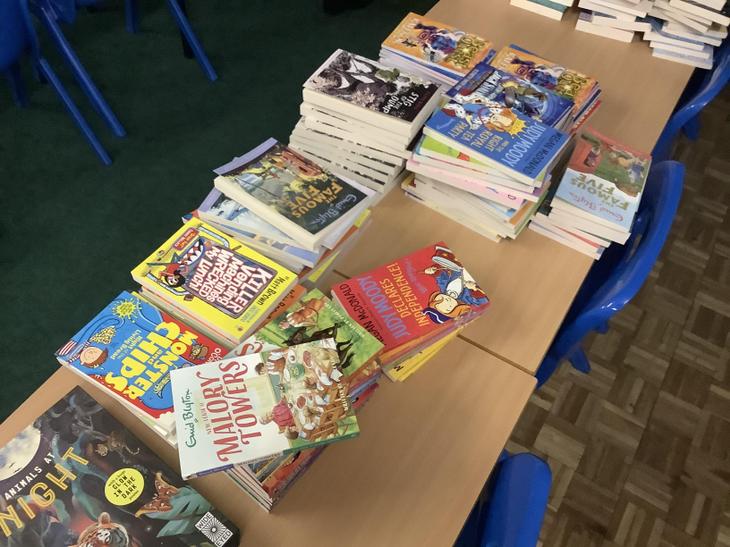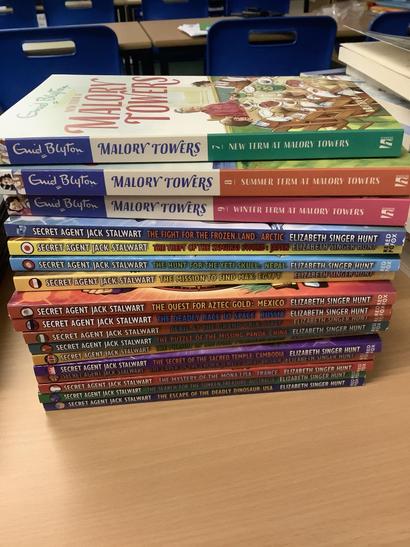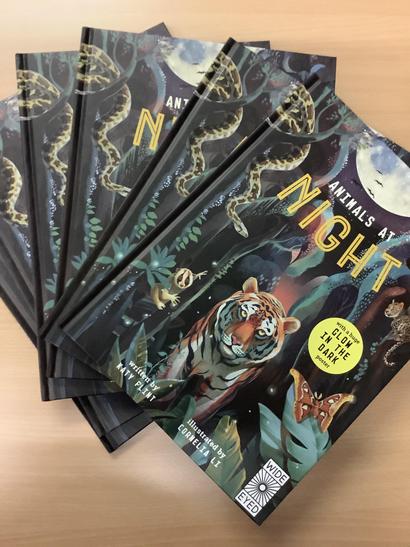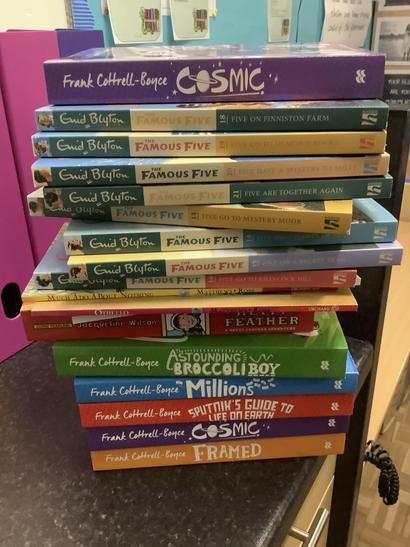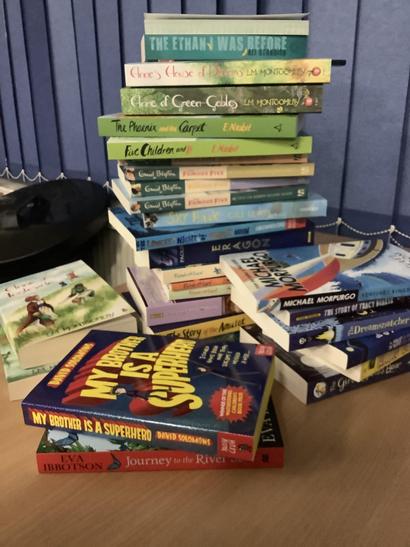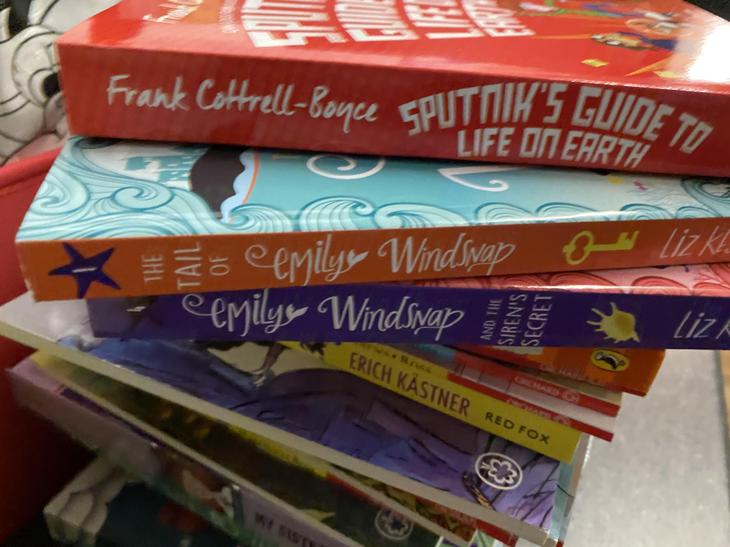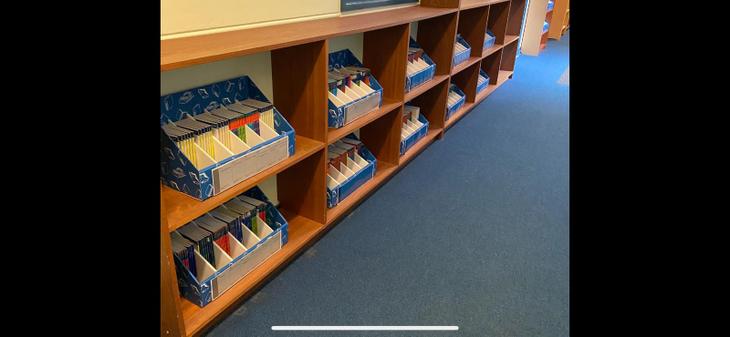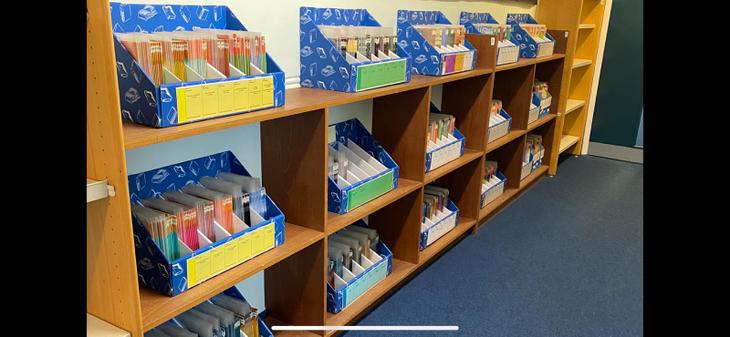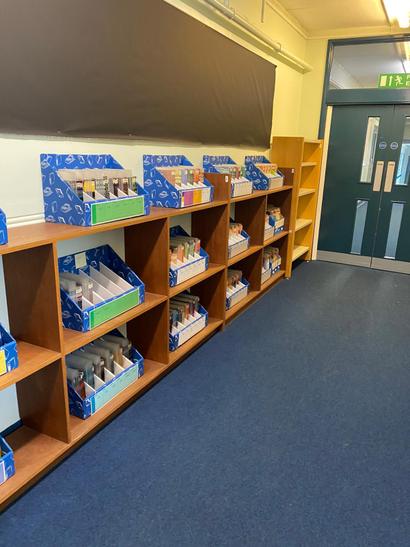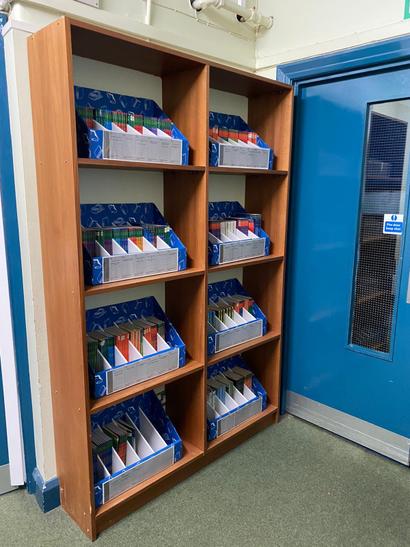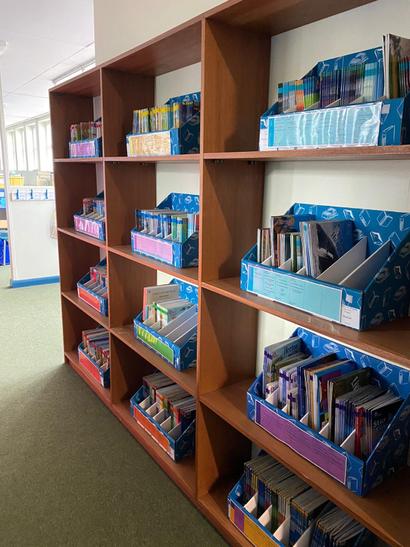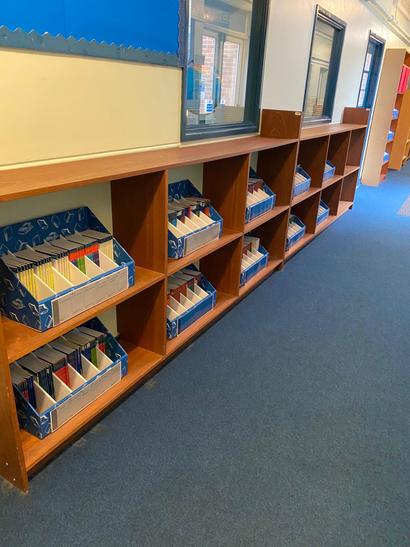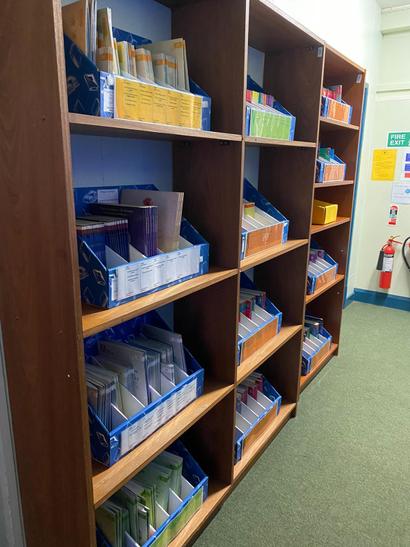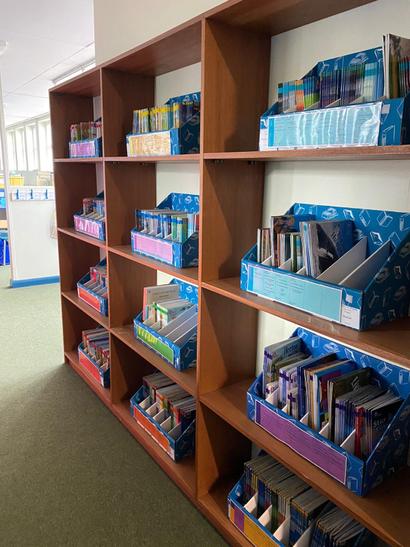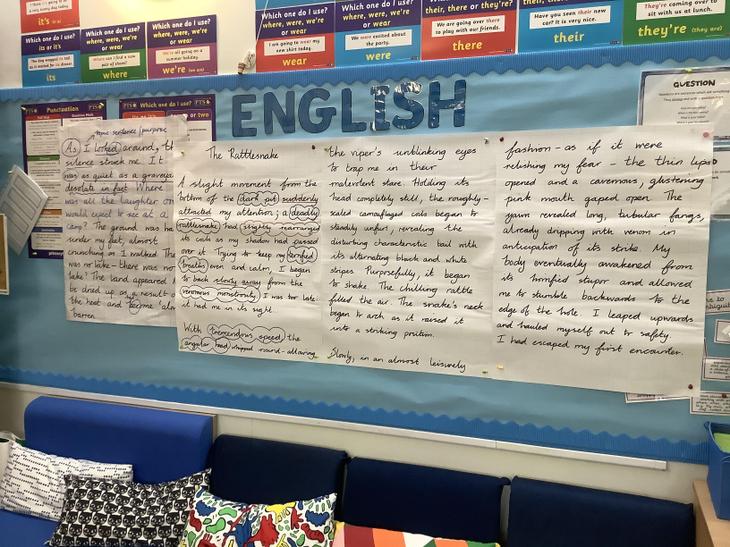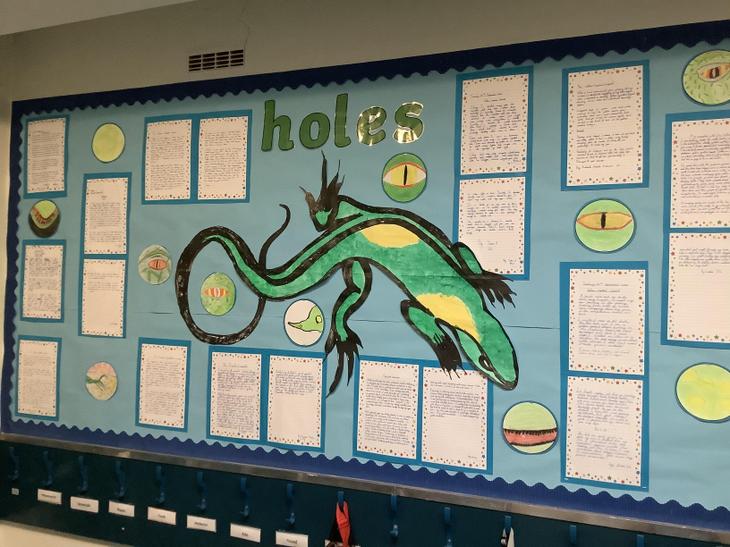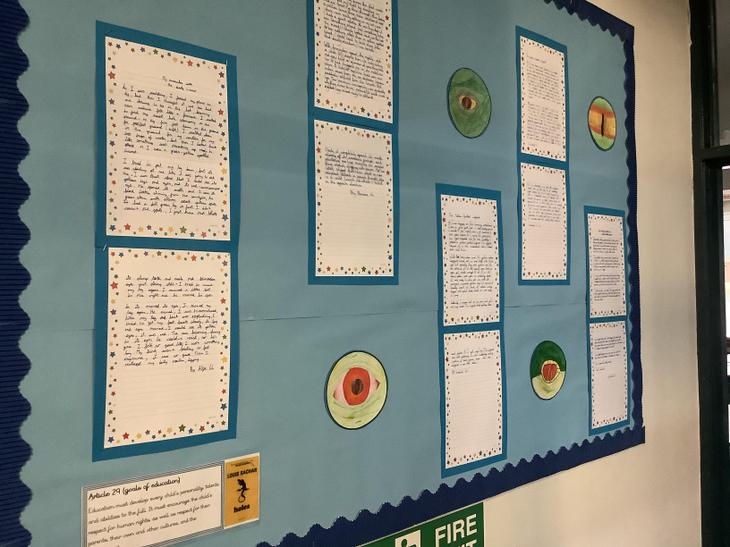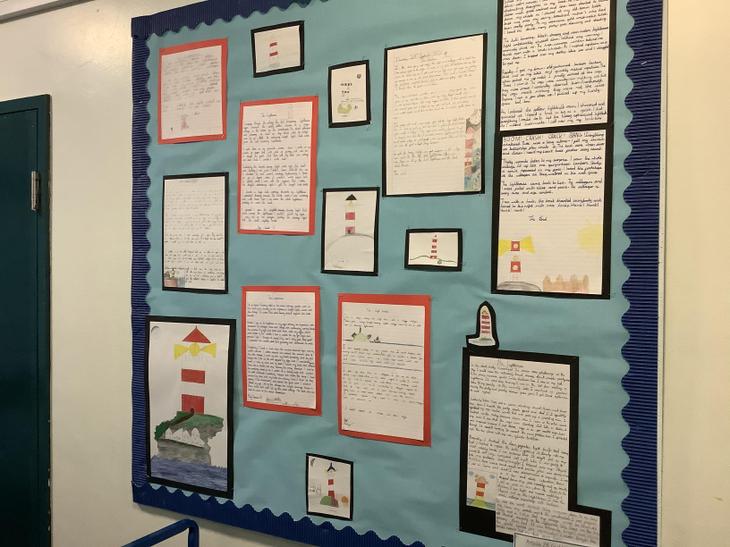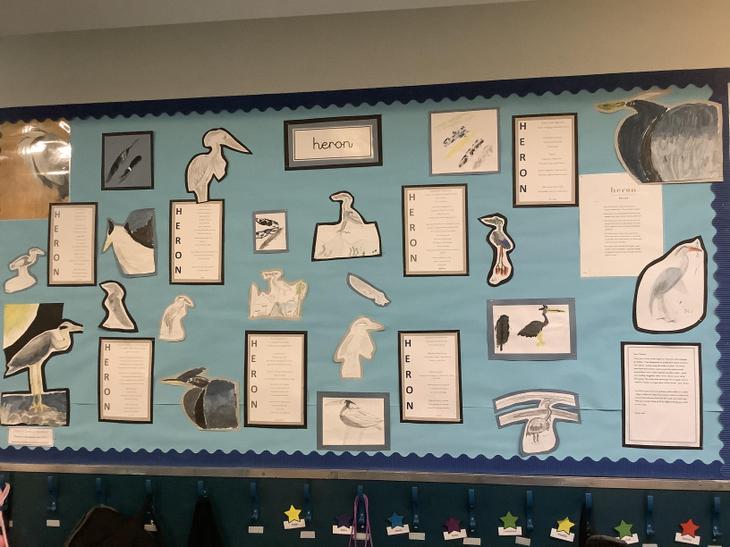Welcome to our English page!
You can click on the stars above to find out about all the different aspects of our English curriculum at Brookfields.
Miss O'Rourke
Our aims in the teaching of English are as follows :
Reading
- That pupils develop an excellent phonic knowledge and skills, which they can use to support them when reading and writing.
- That pupils develop fluency and accuracy in reading across a wide range of contexts throughout the curriculum.
- That pupils develop knowledge of an extensive and rich vocabulary.
- That pupils develop excellent comprehension of texts.
- That pupils feel motivation to read for both study and for pleasure.
- That pupils develop an extensive knowledge through having read a rich and varied range of texts.
- The ability to write fluently and with interesting detail on a number of topics throughout the curriculum.
-
Writing
- That pupils will develop a vivid imagination which makes readers engage with and enjoy their writing.
- That pupils will have highly developed vocabulary and an excellent knowledge of writing techniques to extend details or description.
- That pupils will develop well-organised and structured writing, which includes a variety of sentence structures.
- That pupils will have excellent transcription skills that ensure their writing is well presented and punctuated, spelled correctly and neat.
- That pupils will develop a love of writing and an appreciation of its educational, cultural and entertainment values.
At Brookfields Primary School we believe that for all our children to become fluent readers and writers, phonics must be taught through a systematic and structured phonics programme.

In September 2021 we started using the Little Wandle Letters and Sounds systematic synthetic phonics programme (SSP).
This is a fully comprehensive programme where children start learning single letter sounds in the Autumn Term of their Reception year and it builds in progression throughout Reception and Year One, preparing children for the statutory phonics screening that takes place at the end of year one.
We use the Little Wandle Letters and Sounds Revised to plan and provide daily engaging phonics lessons. In phonics, we teach children that the letters of the alphabet represent a different sound, that these can be used in a variety of combinations and are put together to make words. The children learn to recognise all of the different sounds and combinations that they might see when they are reading or writing. Our phonics teaching starts in Nursery and follows a very specific sequence that allows our children to build on their previous phonic knowledge and master specific phonic strategies as they move through school. As a result, all our children are able to tackle any unfamiliar words that they might discover. At Brookfields we also model these strategies in shared reading and writing both inside and outside of the phonics lesson and across the curriculum. We have a strong focus on the development of language skills for our children because we know that speaking and listening are crucial skills for reading and writing in all subjects.
Here is a copy of our programme overview for Reception and Year 1. If you are unable to open it, it is displayed underneath also.
How we teach phonics and Early Reading (Early Years and KS1)
- In the nursery, children follow the Little Wandle Letters and Sounds Revised ‘Foundations for Phonics’ guidance. The focus is on daily oral blending and language development through high quality stories and rhymes.
- In Reception and Y1, children follow the progression within Little Wandle Letters and Sounds Revised programme. Phonics is taught daily and there is a review session on a Friday.
- Phonics starts in reception in week 2 to ensure the children make a strong start.
- By the end of reception, children will have been taught up to the end of phase 4.
- By the end of Year 1, children will have been taught up to the end of phase 5.
- Children in Year 2 recap any gaps in their phonics knowledge in the autumn term.
- Reception lessons start at 15 minutes, with daily additional oral blending – increasing quickly to 30 minutes.
- Y1 lessons are 30 minutes long.
Reading practice sessions
- Children across reception, year 1, year 2 (and beyond if appropriate) apply their phonics knowledge by using a full matched decodable reader in a small group reading practice session.
- These sessions are 15 minutes long and happen three times a week. There are approximately 6 children in a group.
- The sessions follow the model set out in Little Wandle Letters and Sounds Revised.
- The children then take the same book home the following week to ensure success is shared with the family.
- In reception these sessions start in week 4. Children who are not yet blending take a wordless book home.
Rapid Catch-Up
- When pupils join Brookfields, a phonics assessment is completed to determine what support needs to be put in place to support progress.
- If a pupil is still in need of phonics support, we run rapid catch-up groups. Currently, we have rapid catch-up groups in Y3, Y4 and Y5. Assessment is carried out regularly to monitor progress and ensure pupils have the right support.
Blending Groups
- Where pupils struggle with blending, we have small blending groups in place to support pupils to develop this skill.
- We start to look at oral blending in early years.
Same Day Keep Up
- Where pupils need additional support outside the phonics lesson to stay on track with their learning, daily keep up is in place.
- Pupils are supported in lessons and class teachers identify those needing further support. These pupils then work in a smaller group to them to keep on track with current learning - post tutoring.
Below are some videos, which we used in our most recent parent workshops, to share how the sounds are made.
You may find these useful to support you to make the different sounds your child is learning.
Phase 2 sounds taught in Reception Autumn 1
Here are the sounds your child will be learning in Reception in Autumn 1.
Phase 2 sounds taught in Reception Autumn 2
These are the sounds your child will be learning in Autumn 2 in Reception.
You can access additional videos about our phonics scheme on the following webpages:
https://www.littlewandlelettersandsounds.org.uk/
Why not check out Little Wandle's parent page...
https://www.littlewandlelettersandsounds.org.uk/resources/for-parents/
Why not check out Little Wandle's youtube channel...
https://www.youtube.com/channel/UCP_FbjYUP_UtldV2K_-niWw/videos
At the end of the Autumn term, we purchased lots of new books to add to our class reading areas. The children are very excited and have been involved in selecting some of the titles.
Here are some of our lovely new books!
Remember: your child should be coming home from school every day with a book to read. Please ensure they are reading at home every night for at least 10 minutes.
Miss O'Rourke
Check out our new reading scheme! I am so excited for you to come back to school in September to lots of new books to read! We will be using these books for our guided reading sessions at the end of each day.... all the books are banded, so as readers we know which are appropriate for our age. Check out the book band information sheet below the pictures.
Reading Book Band Chart
|
Year |
Term |
Number |
Book band |
Lexile |
|
FS |
Autumn |
1 |
Pink |
0 -75 |
|
Spring |
2 |
Red |
75 - 125 |
|
|
Summer |
3 |
Yellow |
125 - 200 |
|
|
Year 1 |
Autumn |
4 |
Light Blue |
200 - 225 |
|
Spring |
5 |
Green |
225 - 300 |
|
|
Summer |
6 |
Orange |
300 - 325 |
|
|
Year 2 |
Autumn |
7 |
Turquoise |
325 - 400 |
|
Autumn |
8 |
Purple |
400 - 475 |
|
|
Spring |
9 |
Gold |
475 - 575 |
|
|
Summer |
10 |
White |
575 - 625 |
|
|
Summer |
11 |
Lime |
625 - 650 |
|
|
Year 3 |
Autumn |
12 |
Brown |
650 - 725 |
|
Spring |
12 |
Brown |
650 - 725 |
|
|
Summer |
13 |
Grey |
725 - 750 |
|
|
Year 4 |
Autumn |
13 |
Grey |
725 - 750 |
|
Spring |
14 |
Dark Blue |
750 - 900 |
|
|
Summer |
14 |
Dark Blue |
750 - 900 |
|
|
Year 5 |
Autumn |
14 |
Dark Blue |
750 - 900 |
|
Spring |
14 |
Dark Blue |
750 - 900 |
|
|
Summer |
15 |
Dark Red |
900 - 1000 |
|
|
Year 6 |
Autumn |
15 |
Dark Red |
900 - 1000 |
|
Spring |
15 |
Dark Red |
900 - 1000 |
|
|
Summer |
15 |
Dark Red |
1000+ |
|
|
Independent Readers |
||||
Guided Understanding Overview
At Brookfields we teach reading explicitly daily. One of our daily sessions is our ‘Guided Understanding’. Guided Understanding is 30 minutes long and each week we focus on a new text. Below is an overview of the teaching sequence involved. If you would like to know more about this, ask your child’s class teacher.
|
MONDAY
|
On Monday, we introduce a new text to the class.
When teaching guided understanding on Monday, we focus on the new language your child will come across in the text. We ensure the text is challenging and engaging. |
|
TUESDAY
|
On Tuesday, we continue to work on the same text introduced on Monday.
The teaching in this session will be focused around retrieval and searching the text for key words to help them. |
|
WEDNESDAY
|
On Wednesday, we continue to work on the same text introduced on Monday.
The teaching in this session will be focused around inference – reading between the lines. This session involves identifying what the author is ‘showing us, but not telling us’. |
|
THURSDAY
|
On Thursday, we continue to complete work on the same text, but focus on other skills linked with reading.
Sometimes this can involve sequencing events, predicting what might happen next or explaining their thoughts as readers in a more detailed manner. |
|
FRIDAY
|
On a Friday, all pupils will complete an independent reading task matched to their level.
Ask the teacher if you would like to know more about this. |
Writing is a very important part of our curriculum. We aim to write in every subject!
If you have any questions about our writing curriculum, please speak to the class teachers or come and speak to me.
Miss O'Rourke
Below is the process we follow when teaching writing. It is based on research and studies linked with pupils' progress in writing.
Brookfields Primary School - Writing Process
|
Exploring Stage |
All ‘writing units’ to start with a ‘hook’. An exciting event/film to hook the children’s interest when it comes to writing. For example: if completing a discussion text the children could begin their unit with a debate A focus on oracy within this stage and throughout the writing process.
This stage also explores reading as a writer. The pupils will explore different examples of the text they will be writing. Pupils will explore the structure and composition of the text type.
Pupils to be taught relevant spelling, punctuation and grammar linked with the type of writing they are completing. |
|
Planning Stage |
This stage is all about setting goals (TSC/SC linked with writing expectations and building toolkits for working wall) and generating ideas before pupils begin writing – these goals link with the example texts shared in previous stage. Pupils could write down goals so that they can refer back to them as they write. Example strategies: goal setting, activating prior knowledge, graphic organisers/comic strips/ story mountains, and discussion. |
|
Drafting/Revising Stage |
(Drafting) This stage involves focusing on noting down key ideas. Pupils should set out their writing in a logical order using a planning grid. Although accurate spelling, grammar and handwriting are important, at this stage they are not the main-focus. (Revising) This part of the stage involves making changes to the content of writing in light of feedback and self-evaluation. With pen and paper, it should be accepted that work may become messy but that at this stage the audience will be limited. Example strategies: peers placing a question mark next to things they do not understand and pupils thinking of synonyms for repeated words. |
|
Editing Stage |
This stage involves making changes to ensure the text is accurate and coherent. At this stage, spelling and grammar assume greater importance and pupils will need to recognise that their work will need to be accurate if readers are to engage with it and extract the intended information from it. Example strategies: checking capital letters and full stops and reviewing spellings using a dictionary.
|
|
Publishing Stage |
This stage involves presenting the work so that others can read it. This may not be the outcome for all pieces of writing, but when used appropriately it can provide a strong incentive for pupils to produce high-quality writing and encourage them in particular to carefully revise and edit. Example strategies: displaying work, presenting to other classes, and sending copies to parents and carers. |
|
Throughout the writing process the follow must occur – the teacher to decide the appropriate point for this to happen (formative assessment) |
Sharing — Sharing ideas or drafts throughout the writing process gives pupils feedback. Example strategy: in pairs, listen and read along as the author reads aloud. Evaluating—checking that the writing goals are being achieved throughout the process. This can be done by pupils as they re-read their writing or through feedback from adults or peers. Example strategies: self-monitoring and evaluation by asking questions like, ‘Have I met my goals?’ and ‘Have I used appropriate vocabulary?’ Teacher to teach additional GaPs lessons to support with revising and editing – this is closely linked with teacher feedback throughout the writing process.
|
*** KS1 will be working at the early stages of implementing the following stages for children when teaching writing.
Beginning to introduce these stages in Y1 may look like this:
|
Prewriting activities
‘Exploring Stage’ |
All ‘writing units’ to start with a ‘hook’. An exciting event/film to hook the children’s interest when it comes to writing.
This stage involves engaging children in activities prior to writing that help them think of and organise their ideas. This can involve tasks that encourage them to remember what they already know, find out about a topic they are not familiar with, or arrange their ideas visually (for example, by using a planning tool or graphic organiser) before writing. Focus on developing oracy at this stage and reading as a writer at the early stages.
Planning Stage will differ from Y2/KS2. The planning may be in pictures and captions in Y1. This may also be the case for SEND/exception children across school. |
|
Drafting, revising and editing
|
This stage involves helping pupils to get their ideas written down as a first draft which they can then edit and revise linked with teacher and peer feedback. |
|
Sharing/Publishing |
This stage involves presenting the work so that others can read it. This may not be the outcome for all pieces of writing, but when used appropriately it can provide a strong incentive for pupils to produce high-quality writing and encourage them in particular to carefully revise and edit. Example strategies: displaying work, presenting to other classes, and sending copies to parents and carers. |
|
Throughout the writing process the follow must occur – the teacher to decide the appropriate point for this to happen (formative assessment) |
Sharing - instructing pupils to share, read, and edit each other’s work.
Evaluating – checking that writing goals have been achieved – TSC. This can be done by pupils as they re-read their writing or through feedback from adults or peers. Example strategies: self-monitoring and evaluation by asking questions like, ‘Have I met my goals?’ and ‘Have I used appropriate vocabulary?’ |
At Brookfields Primary School, we use the letterjoin scheme for handwriting.
Your child can use the following code to log on at home:
|
Tablet Edition |
||||
|
User name: |
wk8134 |
|||
|
Swipe code: |
A capital 'L' shape starting at top left. |
|||
|
Home-School Account |
||||
|
User name: |
wk8134 |
|||
|
Account Password: |
home |
|||
In EYFS, we focus our teaching of handwriting around the correct formation of letters and numbers.
In Year 1, pupils build on their knowledge of letter and number formation. In the Spring term pupils begin to explore entry and exit flicks to support joining their letters.
In Year 2, pupils are taught to form lower-case letters which are consistent in size in relation to the capital letters used and with consistent spacing between letters and between words. Throughout Y2, pupils will be taught some of the diagonal and horizontal strokes needed to join handwriting.
In Key Stage 2, pupils are expected to produce neat, legible, joined handwriting with increasing speed and accuracy.
Below are some useful videos to support with key grammar terms your child needs to know by the end of KS2.
Remember to log into studyzone with your child at home to support their learning in this area of English.

Sing with Grammarsaurus - Modal Verbs
GRAMMARSAURUS TEACHES *ALL* SUBJECTS!!!Get your grammar groove on with Grammarsaurus teaching videos. Grammarsaurus brings a new edge to learning grammar wi...
Sing with Grammarsaurus - The Past Perfect Tense
Sing and learn with Grammarsaurus! GRAMMARSAURUS TEACHES *ALL* SUBJECTS!!! Get your grammar groove on with Grammarsaurus teaching videos. Grammarsaurus bring...
Sing with Grammarsaurus - Independent Clauses ft. Co-Ordinating Conjunctions and Semi-Colons
Sing and learn with Grammarsaurus! GRAMMARSAURUS TEACHES *ALL* SUBJECTS!!! Get your grammar groove on with Grammarsaurus teaching videos. Grammarsaurus bring...
Sing with Grammarsaurus - Parentheses (Brackets, Dashes and Commas)
Sing and learn with Grammarsaurus! Looking for teaching resources to match this video? Head over to www.grammarsaurus.co.uk and subscribe so you can access o...
Sing with Grammarsaurus - Nouns
Want to know some of the different types of noun? Check it out here... GRAMMARSAURUS TEACHES *ALL* SUBJECTS!!! Get your grammar groove on with Grammarsaurus ...
Sing with Grammarsaurus - Adverbs and Adverbials
Sing and learn with Grammarsaurus! GRAMMARSAURUS TEACHES *ALL* SUBJECTS!!! Get your grammar groove on with Grammarsaurus teaching videos. Grammarsaurus bring...
Sing with Grammarsaurus - Subordinating Conjunctions
Sing and learn with Grammarsaurus! GRAMMARSAURUS TEACHES *ALL* SUBJECTS!!! Get your grammar groove on with Grammarsaurus teaching videos. Grammarsaurus bring...
Sing with Grammarsaurus - Figures of Speech
GRAMMARSAURUS TEACHES *ALL* SUBJECTS!!! Get your grammar groove on with Grammarsaurus teaching videos. Grammarsaurus brings a new edge to learning grammar wi...
Sing with Grammarsaurus - The Past and Present Progressive Tenses
Sing and learn with Grammarsaurus! GRAMMARSAURUS TEACHES *ALL* SUBJECTS!!! Get your grammar groove on with Grammarsaurus teaching videos. Grammarsaurus bring...
Spelling
At Brookfields Primary School, we follow the ‘No Nonsence’ spelling scheme. This is taught in Y2 – Y6. The lessons follow the same structure as our phonics lessons and normally last for approximately 20 minutes. These lessons take place between 9 am – 9:20am – this is why it is important your child is in school every day on time!
Your child will be issued with new spellings every week and will be tested on these every Thursday.
Structure of our lessons:
|
Revisit |
|
Activate prior knowledge. Revisit previous linked learning. |
|
Teach |
|
Introduce the new concept. Explain Investigate Model |
|
Practise |
|
Individual/group work Extend/explore the concept independently Investigate Generate |
|
Apply and Assess |
|
Assess through independent application Explain and demonstrate understanding |
Strategies used by teachers within lessons that could also be used at home:
|
Look, say, cover, write, check |
This is probably the most common strategy used to learn spellings. |
|
Trace, copy and replicate (and then check) |
This is a similar learning process to ‘look, say, cover, write, check’ but is about developing automaticity and muscle memory. If this is easy, do the same process for two different words at the same time. Once you have written all your words this way and feel confident, miss out the tracing and copying or the tracing alone and just write the words. |
|
Segmentation strategy |
The splitting of a word into its constituent phonemes in the correct order to support spelling. |
|
Quickwrite |
Writing the words linked to the teaching focus with speed and fluency. The aim is to write as many words as possible within a time constraint. This can be turned into a variety of competitive games including working in teams and developing relay race approaches. |
|
Drawing around the word to show the shape |
Draw around the words making a clear distinction in size where there are ascenders and descenders. Look carefully at the shape of the word and the letters in each box. Now try to write the word making sure that you get the same shape. |
|
Have a go |
The process by which children try different possible spellings of a word they want to write but don’t know, in order to see which is the most like- ly. Typically, children would write three versions and then choose which one looks right.
|
|
Quick Write |
Writing with speed and fluency the words linked to the teaching focus. The aim is to write as many words as possible within a time constraint. Children can write words provided by the teacher or generate their own examples e.g. in two minutes write as many words as possible with the /ai/ phoneme. This can be turned into a variety of competitive games including working in teams and developing relay race approaches.
|
|
Proof Reading |
The process of checking writing for spelling and punctuation errors. This task is often done with a spelling buddy (Spuddy).
|
|
Count Down |
Practise reading/blending with speed and fluency. The aim of the activity is to read as many words as possible before the time limit runs out. Children need to read words linked to teaching focus with the time constraint. This can be turned into a variety of games including using teams and a relay race approach.
|
|
Modelling |
An activity is described, and it is anticipated that the action expected of the children is modelled to them rst.
|
|
Spelling Buddy ‘Spuddy’ |
Children are asked to work in pairs, often to ‘test’ each other. They will be asked to work with their ‘Spuddy’ or spelling buddy, from time to time.
|
|
Wall Charts |
Classroom displays can also be made using the word lists supplied.
|
Grammar and Punctuation
Below is the overview of the teaching in grammar and punctuation that your child will receive throughout their time at Brookfields. The key elements outlined will help them when writing.
If you keep scrolling, you will see our knowledge organisers for each year group in this area of study.
Progression in Grammar
|
YEAR 1 |
YEAR 2 |
YEAR 3 |
YEAR 4 |
YEAR 5 |
YEAR 6 |
|
Noun phrases
Word classes |
Expanded nouns phrases
Word classes |
Expanded noun phrases
Word classes |
Expanded noun phrases
Word classes |
Expanded Noun phrases
Word classes |
Expanded Noun phrases
Word classes |
|
Subordinating conjunctions
Co-ordinating conjunctions |
Subordinating conjunctions
Co-ordinating conjunctions |
Subordinating conjunctions
Co-ordinating conjunctions |
Subordinating conjunctions
Co-ordinating conjunctions |
Subordinating conjunctions
Co-ordinating conjunctions |
Subordinating conjunctions
Co-ordinating conjunctions |
|
Past and present tense are consistent
|
Past simple Past progressive Present simple Present progressive
|
Past simple Past progressive Present simple Present progressive Past perfect Present perfect
|
Past simple Past progressive Present simple Present progressive Past perfect Present perfect
|
Past simple Past progressive Present simple Present progressive Past perfect Present perfect
|
Past simple Past progressive Present simple Present progressive Past perfect Present perfect
|
|
Sentence types – what makes a sentence a sentence.
|
Sentence types: Statement Command Question Exclamation
|
Sentence types: Statement Command Question Exclamation
|
Sentence types: Statement Command Question Exclamation
|
Sentence types: Statement Command Question Exclamation
|
Sentence types: Statement Command Question Exclamation
|
|
|
Adverbs (adverb starters and within sentences)
|
Adverbials
|
Adverbials
|
Adverbials
|
Adverbials
|
|
|
|
|
|
Relative clauses and relative pronouns Modal verbs
|
Relative clauses and relative pronouns Modal verbs
|
|
|
|
|
|
|
Subjunctive form |
Progression in Punctuation
|
YEAR 1 |
YEAR 2 |
YEAR 3 |
YEAR 4 |
YEAR 5 |
YEAR 6 |
|
Capital letters Full stops Exclamation marks Question marks |
Capital letters Full stops Exclamation marks Question marks
Speech marks/inverted commas |
Capital letters Full stops Exclamation marks Question marks
Speech marks/inverted commas |
Capital letters Full stops Exclamation marks Question marks
Speech marks/inverted commas |
Capital letters Full stops Exclamation marks Question marks
Speech marks/inverted commas |
Capital letters Full stops Exclamation marks Question marks
Speech marks/inverted commas |
|
|
Commas to separate a list
|
Commas to separate a list
|
Commas to separate a list
|
Commas to separate a list
|
Commas to separate a list
|
|
|
Apostrophe for omission and possession.
|
Apostrophe for omission and possession.
|
Apostrophe for omission and possession.
|
Apostrophe for omission and possession.
|
Apostrophe for omission and possession.
|
|
|
|
Commas for fronted adverbials
|
Commas for fronted adverbials
|
Commas for fronted adverbials Commas for clarity Parentheses Dashes Brackets Commas Hyphens
|
Commas for fronted adverbials Commas for clarity Parentheses Dashes Brackets Commas Hyphens
|
|
|
|
|
|
|
Adding detail Dashes Colons Linking Semi-colons |
SPAG Knowledge Organisers
|
Year Group |
Type of Poem |
Model Example to use |
|
EYFS |
A collection of poems linked with language and communication in EYFS
|
Five Garden Snails & additional collection of animal poems |
|
Year 1 |
Rhyming Poems Acrostic Poems |
Teddy bears Stars |
|
Year 2 |
Classic humorous poems Concrete poems |
Old Mother Hubbard humorous poem by Sarah Catherine Martin Butterfly |
|
Year 3 |
Free verse poems Nonsense poems |
School Jabberwocky by Lewis Carroll |
|
Year 4 |
Haiku poems Kenning poems |
City and village life (2 poems) Tiger |
|
Year 5 |
Limerick poems Sonnet peoms *** additional unit of work based around narrative poem the highway man (unit study) |
Nonsense Limericks by Edward Lear Sonnet 18 by William Shakespeare (Rhyming pattern ABAB CDCD EFEF GG) |
|
Year 6 |
Ode poems Narrative poems |
Music festivals The Raven by Edgar Allen Poe |







